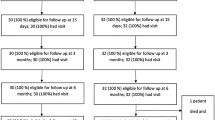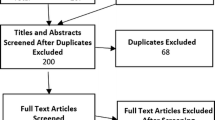Abstract
Commercially available polypropylene mesh is preferred in the developed countries during inguinal hernioplasty. Whereas, the mosquito net mesh is a safe and effective alternative in the developing countries such as India. To evaluate the safety and efficacy of mosquito net mesh as prosthesis in comparison with polypropylene mesh in inguinal hernia repair by Lichtenstein tension-free technique. A total of 60 patients presented with uncomplicated inguinal hernia were randomized into two groups: group A (mosquito net mesh) and group B (polypropylene mesh). Postoperatively, the Southampton scoring system was employed to assess the level of infection at the surgical site on days 3, 5, 7, and 10. The data obtained were analyzed using SPSS 20.0. The data were compared using Fisher’s exact test, chi-square test, and independent sample t test. P ≤ 0.05 was considered statistically significant. All the patients were men and majority were in the age-group of 51–60 years. Right-sided inguinal hernia was reported in most (30) of the patients. The rate of surgical site infection on postoperative day 3 (P = 1.000), 5 (P = 0.704), 7 (P = 0.612), and 10 (P = 1.000) were comparable in both groups A and B. The baseline characteristics, clinical presentations, and assessment of surgical site infection in both groups were comparable. Therefore, mosquito net mesh, as prosthesis for inguinal hernia repair, is equally safe and efficacious as polypropylene mesh.



Similar content being viewed by others
References
Neumayer L, Giobbie-Hurder A, Jonasson O, Fitzgibbons R Jr, Dunlop D, Gibbs J, Reda D, Henderson W, Veterans Affairs Cooperative Studies Program 456 Investigators (2004) Open mesh versus laparoscopic mesh repair of inguinal hernia. N Engl J Med 350(18):1819–1827
Jenkins JT, O’Dwyer PJ (2008) Inguinal hernias. Br Med J 336(7638):269–272
Kingsnorth A, LeBlanc K (2003) Hernias: inguinal and incisional. Lancet 362(9395):1561–1571
Devlin H (1995) Trends in hernia surgery in the land of Astley Cooper. Problems in Gen Surg 12:85–92
Kumar B, Madhusoodhanan N, Balaji A, Poornima M (2014) Prevalence and risk factors of inguinal hernia: a hospital based observational study. Int J Med Appl Sc 3(4):191–198
Gandhi D, Marcin S, Xin Z, Asha B, Kaswala D, Zamir B (2011) Chronic abdominal pain secondary to mesh erosion into cecum following incisional hernia repair: a case report and literature review. Ann Gastroenterol 24(4):321–324
Adesunkanmi ARK, Badmus TA, Ogundoyin O (2004) Determinants of outcome of inguinal herniorrhaphy in Nigerian patients. Surg Pract 8(1):14–21
Darokar A, Bele K, Mulmule R, Qazi R (2016) Study of open inguinal hernia repair by mosquito net mesh versus polypropylene mesh. Int J Res Med Sci 4(1):126–130
Stephenson B, Kingsnorth A (2011) Inguinal hernioplasty using mosquito net mesh in low income countries an alternative and cost effective prosthesis. Surgery: Br Med J 18:1237–1247
Tongaonkar RR, David L, Kingsnorth AN (2013) Ten-year personal experience of using low density polyethylene (LDPE) mesh for inguinal hernia repair. Trop Med Surg 1:136. https://doi.org/10.4172/2329-9088.1000136
Williams NS, Bailey H, Bulstrode CJ, Love RM, O’Connell PR (2008) Bailey & Love’s short practice of surgery. Crc Press, Boca Raton
Gottrup F, Melling A, Hollander DA (2005) An overview of surgical site infections: aetiology, incidence and risk factors. EWMA Journal 5(2):11–15
Freudenberg S, Sano D, Ouangré E, Weiss C, Wilhelm TJ (2006) Commercial mesh versus nylon mosquito net for hernia repair. A randomized double-blind study in Burkina Faso. World J Surg 30(10):1784–1789
Kiss A, Corona D, Kiss O (2012) The use of mosquito-net cloths as prosthesis in inguinal hernia repair: an experience in Southern Sudan. Surgical Science 3(03):155
Hair A, Duffy K, McLean J, Taylor S, Smith H, Walker A, Macintyre IMC, O'Dwyer PJ (2000) Groin hernia repair in Scotland. Br J Surg 87(12):1722–1726
Author information
Authors and Affiliations
Contributions
All authors contributed in the development of the manuscript.
Corresponding author
Ethics declarations
Conflict of Interest
The authors declare that they have no conflict of interest.
Additional information
Publisher’s Note
Springer Nature remains neutral with regard to jurisdictional claims in published maps and institutional affiliations.
Rights and permissions
About this article
Cite this article
Pradhan, R., Pangi, A. Use of Mosquito Net Mesh Versus Polypropylene Mesh in Tension-Free Repair of Inguinal Hernia: a 1-Year Randomized Controlled Trial. Indian J Surg 82, 1063–1066 (2020). https://doi.org/10.1007/s12262-020-02216-9
Received:
Accepted:
Published:
Issue Date:
DOI: https://doi.org/10.1007/s12262-020-02216-9




